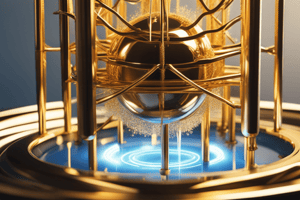Podcast
Questions and Answers
What is the primary function of an electroscope?
What is the primary function of an electroscope?
- To detect electric charge. (correct)
- To measure electric current directly.
- To generate static electricity.
- To store electric charge.
Which of the following best explains induced charge separation?
Which of the following best explains induced charge separation?
- The immediate transfer of electrons between two touching objects.
- The permanent transfer of charge from one object to another.
- When two neutral objects develop charge through friction.
- The process where a charged object is brought close to a neutral object, causing a shift in charge distribution. (correct)
What method involves charging an object by touching it with a charged object?
What method involves charging an object by touching it with a charged object?
- Charging by contact. (correct)
- Charging by grounding.
- Charging by induction.
- Charging by friction.
Why is static cling more noticeable in winter?
Why is static cling more noticeable in winter?
How do lightning rods provide safety against electrical discharge?
How do lightning rods provide safety against electrical discharge?
What is the primary purpose of the electrostatic series chart?
What is the primary purpose of the electrostatic series chart?
Which method describes how an object can become permanently positively charged after being charged by induction?
Which method describes how an object can become permanently positively charged after being charged by induction?
How do electrostatic precipitators function in air pollution control?
How do electrostatic precipitators function in air pollution control?
What is the role of grounding in static electricity?
What is the role of grounding in static electricity?
Which factor contributes to the intensity of static cling during winter months?
Which factor contributes to the intensity of static cling during winter months?
Flashcards
Static Electricity
Static Electricity
A buildup of electric charge on an object.
Electrostatic Series
Electrostatic Series
A list of materials arranged by their tendency to gain or lose electrons upon contact.
Charging by Friction
Charging by Friction
Transfer of electrons from one object to another due to rubbing.
Charging by Contact
Charging by Contact
Signup and view all the flashcards
Charging by Induction
Charging by Induction
Signup and view all the flashcards
What happens when objects touch?
What happens when objects touch?
Signup and view all the flashcards
How do charged objects attract neutral objects?
How do charged objects attract neutral objects?
Signup and view all the flashcards
How does an electroscope work?
How does an electroscope work?
Signup and view all the flashcards
What is grounding?
What is grounding?
Signup and view all the flashcards
How does charging by induction work?
How does charging by induction work?
Signup and view all the flashcards
Study Notes
Static Electricity
- Static electricity occurs when objects gain or lose electrons.
- When objects touch, electrons can transfer, resulting in either both objects becoming charged or one gaining charge and the other losing it.
- Electrostatic discharge is a transfer of charge where two objects have different charges.
Electroscopes
- Electroscopes are instruments used to detect electric charges.
- They work by using a metal rod to detect charge, and the deflection of a pointer (or leaves) indicates the magnitude of the charge.
Law of Electric Charge
- Like charges repel, and unlike charges attract.
- Charges on an object are typically balanced so the object appears neutral.
Induced Charge Separation
- A neutral object can have charges separated without direct contact with a charged object.
- If you bring a negatively charged object near a neutral object, electrons will be repelled to the opposite side of the neutral object creating a temporarily positive and negatively charged side of the object.
Applications of Static Electricity
- Electroscopes: Detect charge.
- Paint sprayers: Ensure the paint adheres to the object.
- Dusters: Attract dust to remove it.
- Precipitators: Trap pollutants during emissions.
Charging Objects
- Friction: Rubbing two objects together transfers electrons.
- Contact: Transferring electrons by direct contact.
- Induction: Charging an object using another charged object, inducing a charge of opposite polarity on the object.
Electrostatic Series
- A chart showing the tendency of materials to gain or lose electrons when rubbed together.
- Used to predict the charge developed on materials during friction.
- Example: Wool (with electrons) will give up electrons to silk (gaining electrons).
Static Cling and Winter
- Static cling is worse in winter due to the low humidity.
- Low humidity prevents the air from holding moisture, leading to an increase in static charge on objects.
Charging by Contact
- Transferring electrons by physical contact with a charged object.
- The object now has a similar charge as the charging object
Grounding
- Transferring excessive electrons to the earth.
- A method of eliminating a static charge.
Conductors and Insulators
- Conductors allow electrons to move freely.
- Insulators prevent electrons from moving freely, creating build-up of static electricity.
Charging by Induction
- Temporarily changing the charge distribution on a neutral object.
- A charged object is brought close to the neutral object, causing separation of charges without direct contact.
Permanent Charging by Induction
- Charging an object permanently by induction requires a third metal object and temporarily charges it.
- This object becomes permanently charged after momentarily transferring the charge in an induced object to oppositely charged object.
Electrical Discharge
- Flow of electrons from an object with excess electrons to an object with a deficiency.
- Occurs when the charge difference becomes very high leading to an electrical spark or discharge.
Lightning Rods
- Conductors that protect buildings from lightning strikes.
- The pointed structure rapidly discharges the built up excess charge.
Studying That Suits You
Use AI to generate personalized quizzes and flashcards to suit your learning preferences.




